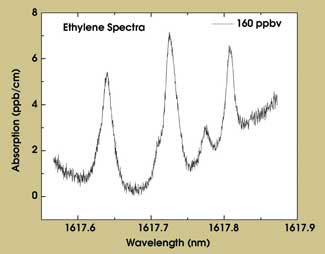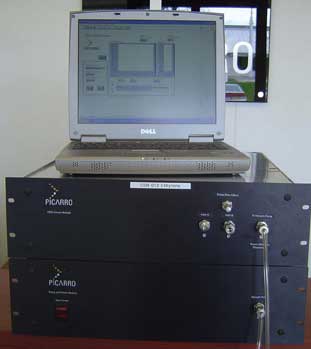
Cavity Ringdown Spectroscopy Monitors Ethylene
Anne L. Fischer
The plant hormone ethylene, which regulates growth and development, can lead to the overripening of fruits and vegetables. Ethylene from plants as well as from sources such as engine exhaust, therefore, is closely controlled in greenhouses, in packing plants and in distribution centers.
Gas chromatography has been the typical method for the detection of ethylene concentration. Various fruits and vegetables vary in ethylene sensitivity, and the standard for ethylene detection has been less than 1 part per million. However, some fruits, such as kiwi, are damaged at much lower levels, said Edward H. Wahl, an application engineer at Picarro Inc. of Sunnyvale, Calif., which makes ethylene monitors based on cavity ringdown spectroscopy.

Ethylene spectra were measured at various concentrations; here, at 160 parts per billion by volume.
Specialized detectors on gas chromatography monitors can produce sensitivity of a few parts per billion, but such systems require laboratory personnel who are highly trained. Furthermore, the monitors must be operated in a laboratory setting rather than, for example, on the floor of a packing plant.
In contrast, Picarro’s cavity ring-down spectroscopy system uses a laser-based optical absorption technique that can be implemented on-site. Moreover, the developers have found that it can be operated by users with basic computer skills.
The system incorporates a 20-mW distributed feedback laser that is tuned around the ethylene peaks near 1617 nm. The output is directed into a custom high-resolution optical wavelength meter and then into a three-mirror cavity system. Wahl said that the design is particularly stable because the mirrors are attached to a monolithic tube with flat surfaces. A custom photodetector monitors the signal that leaks out of one of the mirrors.

The cavity ringdown spectroscopy instrument is designed for monitoring trace ethylene.
A 14-bit analog-to-digital card digitizes the output of the detector, and a digital signal processing card analyzes the output to determine the ringdown time, which is related to the absorption loss of the gas. By measuring the ethylene absorption spectrum, the system provides a real-time measurement of the ethylene concentration, which can be used to assess the effectiveness of ethylene filters or to determine how much ventilation is needed to keep the levels of the gas below produce-damaging levels. In tests, the system achieved a detection limit of two parts per billion in 4.4 min.
The cavity ringdown spectroscopy system was benchmarked against a gas chromatography system at the University of California, Davis. The performance of the two was similar, but because the former measures absolute optical loss, once a calibration is made relating loss to concentration, all systems using the same calibration will produce consistent readings. Another advantage of the approach is that its real-time on-site monitoring capability enables early detection of problems.
Ethylene monitoring systems would be of benefit to food packing and transportation, but their cost often is prohibitive for these businesses, which tend to be of the mom-and-pop type, Wahl noted. The systems are of value in postharvest research, helping agricultural scientists to understand the impact of ethylene on horticultural products and to develop growing and storage guidelines and improved packing materials.
Optics Express, Feb. 20, 2006, pp. 16731684.
/Buyers_Guide/Picarro_Inc/c11824